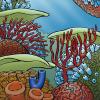-
Posts
1,236 -
Joined
-
Last visited
About Highland Reefer
- Birthday 01/29/1953
Contact Methods
-
Website URL
http://www.apccoinc.com
-
ICQ
0
Custom Fields
-
Gender
Male
-
Location
Highland, Maryland 20777, which is near Clarksville in Howard County.
Recent Profile Visitors
556 profile views
Highland Reefer's Achievements

Grandmaster Reefer (9/13)
-
You have written a nice synopsis for hair algae in the reef tank Paul.
-
Yep. Watching the Colts game as well. I'm getting better at multi-tasking, but my wife has me outclassed by far.
-
There are lengthy threads on RC for every biopellet manufacturer going in the Chemistry Forum. There does not seem to be any difference in the results achieved. All the product's individual threads do contain too many posts where the hobbyists experienced bacterial blooms when using the pellets in high nitrate systems. This is somewhat alarming to me, but the hobbyists that have experienced these bacterial blooms in the water coll um do not seem to have negative results. Blooms in the water column make me feel that the bio-polymers are getting into the water column to a large degree. For this reason, I believe the amount of biopellets one starts with should start at a fraction of the recommended rate and then increased slowly, especially if nitrate is high.
-
From all the posts I have seen regarding all the biopellets available including the PCL, they all seem to work pretty much equally well. If your reactor water flow is too high, this can cause problems. You can slow the flow up until the pellets start to stick together and then increase a bit to prevent the pellets from sticking together. If the pellets stick together, you got bacteria growing on them.
-
The flow was determined by preventing too much bacterial growth to clog the reactor too quickly. You need enough flow to sluff off the bacteria biomases and not too much to prevent the biomasses from developing. I would start with slower flow and increase as needed. The biopelelts will still tumble to some degree and some of the pellets will escape to the top of the reactor, which did not cause problems. They only experiemented with fine sand, medium sand & the 4-6 cm diameter gravel. The gravel work dramatically better than the sands.
-
Tom, Perhaps your system is too low in nutrients, since you don't see growth on the biopellets. Poor coral growth with low nutrient levels would imply this to me. It can't be off by much though.
-
The gravel used was aragonite in both the patent and by several hobbyists that are successfully doing this now. Fine sand does not work per the patent, only the coarse gravel. The aragonite gravel would be much more porous than quartz.
-
Removing the GFO sounds good as well to me as long as your pests stay under control and your phosphate levels don't climb to detectable levels. Trying to control cyano and pest algae while maintaining needed nutrients for your coral is trickly as you know. Only close observations will tell. Hopefully removing the GFO will allow needed nutrients to allow your coral to grow better. I noticed in my system, that running too much GFO did slow the growth of my coral, and I stopped using it with better results. Perhaps running too much carbon could strip too many nutrients from your system as well. Experimenting with how often you run GAC may show benefits as well.
-
IMO, if you can see the biomasses, they are thick enough to reduce the N sources including nitrate to N2. There are different pathways that nitrate can take to get to N2 gas. The gelatinous secretions produced by bacteria, do reduce O2 from entering and circulating around as the biomass grows and at the same time allow the smaller molecules to enter and circulate. Nutrients are absorbed by the aerobic organisms and then their byproducts are passed down from bacterial type to bacterial type into the anaerobic portions of the biomass. IMHO, these biopellets are not the best substrate to grow biomasses on, based on the research for the Instant Ocean PCL patent and results I have seen hobbyists accomplish on one thread on RC. From the IO patent it is obvious that the bacterial biomasses grow and multiply quicker when 4-6 cm diameter gravel is mixed in with the biopellets. The hobbyists that have tried this are able to replace anywhere from 30% to 70% of the biopellets with the coarse gravel with the same results. Obviously the gravel provides a better substrate for bacterial biomasses to grow. As far as whether the pellets get into the water column, I would assume that there is at least some sloughing off of the pellets and perhaps some material is dissolved into the water column, I don't know and have seen no research regarding this.
-
Well in a tank with low nutrient levels, low phosphate & low nitrate, even with an added carbon source available, bacterial growth rates may be slow. Still, I would assume you see good brown skimmate production, especially if feeding rates are higher. If your tank nutrient levels were previously low, I don't know that you would see any spectacular results. Some hobbyists experiment with added food sources which the biopellets would help prevent nutrient buildup and state they get better coral coloration. If your goal would be to increase fish populations I could see where the biopellets could help. Other than that, if your nutrient levels are low, I don't believe biopellets are necessary. I look at biopellets as a method for nitrate control & phosphate (if the added phosphate is not to high), where better filtration methods & the standard maintenance procedures are not adequate. If you are able to stop using GFO where previously you could not, I would consider this an accomplishment. How the price comparison works out, I'm not sure.
-
Tom, The first stage of forming a biomass is that single bacteria attach to the surface of the biopellets. You can actually see these biomasses on the pellets & if water flow through reactors or filter bags is to slow the polymers formed by bacteria that have congregated together will further glue the bacterial biomasses to the surface. As the biomasses continue to multiply, eventually the biomass become to large and water flow will slough off parts of the biomass. These biomasses left unchecked can get quite large. So the size of biomasses in the filters can be quite thick depending on water flow..........etc. A large bacteria biomass: Huge bacterial slime mass with diver
-
Another link that explains how the different type of bacteria found in bacterial biofilms utilize carbon and energy sources: http://books.google....motroph&f=false
-
FWIW, BRS is now in the biopellet game. They are selling a PHA product at a good price. BRS's directions for use of their product are the best I have seen so far. http://www.bulkreefsupply.com/store/BRS-Bio-Pellets This is an interesting video demonstrating how quickly a bacterial biofilm can develop. Notice this video takes place over an 8 hr period. You can also see the biopolymer slime secreted by the bacteria developing around colonies, which adds to the protection of a bacterial colony as well as its complexity. Some of the recent research has found that bacteria have some kind of a capability to intercommunicate with each other as well. At least they can detect other bacteria's presence to build these slime layers. Wenyuan Shi Biofilm Formation
-
Bacterial mats found on the bio-pellets as well as other surfaces found in a reef aquarium like rock and sand beds are quite complicated. They are composed of layers of different type of bacteria, both aerobic and anaerobic. The different types of bacteria act together as a whole to reduce the different waste products dissolved in reef tank water. Regarding the nitrogen cycle, the methods of brake down can take many forms as is depicted in this diagram: (Needless to say it is complicated.)
-
I've not used any of the products or hobbyist substitutes, but isn't this the standard protocol (to start small - 1/2 of the required amount, I believe - and to build up the quantity a few weeks later) for these products? The directions for the BP Biopellets, I believe, state to use a certain amount per water volume. They don't provide much help on the label from what I understand. I have not seen the label. They do state to use enough flow through the reactor used to keep the Biopellets moving. I believe that some hobbyists have too much flow, which may cause problems. Enough flow should be used to keep the reactor basically aerobic & produce no sulfur odor. I agree that hobbyists should start with a small amount and increase it slowly looking for signs of bacterial blooms. Most hobbyists want to see results within a month, which may not be the case if they have high nitrate levels. It takes time to reduce high nitrate levels safely IMHO. Once nitrate is dropped to a zero reading, I would assume that reducing the amount used to 1/2 the amount would be appropriate and work from there. This is what is recommended for vodka dosing. Tom, if you decide to use the Mirel products, I would be interested in the results. I have not seen posts where you could buy the product until the above. Perhaps this is why hobbyists have not tried it.




